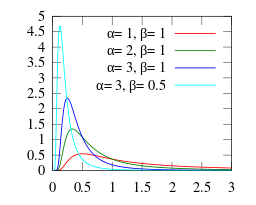Non Normal Distributions > Inverse Gamma Distribution
What is the Inverse Gamma Distribution?

The inverse gamma distribution (also called the inverted gamma distribution) is the reciprocal of the gamma distribution. It has two positive parameters (α and β):
- The shape parameter α controls the height. The higher the alpha, the taller the probability density function (PDF); higher values for the shape parameter will also result in thinner tails.
- The scale parameter β controls the spread.
The shorthand for the distribution, X~inverted gamma(α,β), or IG(α, β), means that a random variable X has this distribution with positive parameters α and β.
The generalized inverse gamma distribution has two additional parameters:
- The mean, μ. This is always zero in the two-parameter version.
- γ, which controls the concentration near the x-axis. This is always set to 1 in the two-parameter version.
The distribution spreads over the interval μ to &infinity;. As values for x increase, the function decreases exponentially, giving the inverse gamma distribution very thin tails.
PDF, Mean & Variance
The inverted gamma distribution has the PDF:

The distribution is closely related to the chi square distribution: the PDF of the inverse gamma distribution [ν, 1/2] is the same as the Inverse Chi Square Distribution.
The mean (for α > 2) is:
E(X) = β / (α – 1).
The variance is:
β2 / ((α – 1)2*(α – 2)).
Uses
The main function of the inverse gamma distribution is in Bayesian probability, where it is used as a marginal posterior (a way to summarize uncertain quantities) or as a conjugate prior (a prior is a probability distribution that represents your beliefs about a quantity, without taking any evidence into account). In other words, it’s used to model uncertain quantities.
The inverse gamma distribution is also used in machine learning, reliability theory (a general theory about systems failure), and survival analysis.
Note: Different textbook authors have different ways of showing parameterization for this distribution (this isn’t too unusual, as many distributions can be parameterized in different ways). When creating a distribution, double check that you are using the correct parameters.